Introduction
In a world where physical fitness is paramount, advanced core exercises stand out as a game-changer for enhancing strength and stability. These dynamic movements push beyond traditional routines, engaging multiple muscle groups and challenging the body in innovative ways. As research highlights their effectiveness in boosting athletic performance and preventing injuries, it becomes clear that integrating these exercises into fitness regimens is essential.
From hanging leg raises to Turkish get-ups, the array of options available not only cultivates functional strength but also promotes a healthier lifestyle. For HR Benefits Managers, advocating for advanced core training within their teams can inspire a culture of wellness, ultimately leading to improved performance both in and out of the workplace. Embracing these powerful workouts is not just about fitness; it's about empowering individuals to unlock their full potential.
Defining Advanced Core Exercises: What Sets Them Apart
Core exercises advanced extend beyond basic stabilization, challenging the core muscles in ways that traditional workouts cannot. While traditional workouts like crunches and planks primarily focus on simple movements, incorporating core exercises advanced routines embraces dynamic movements, instability, and resistance, effectively engaging multiple muscle groups at once. These activities require an elevated degree of coordination, balance, and power, rendering them essential for athletes and fitness fans seeking to improve their performance.
Significant instances consist of the following:
- Hanging leg raise
- Stability ball rollouts
- Turkish get-up
These exercises enhance functional strength and stability through intricate activation of the midsection. Recent studies have demonstrated that activities such as the Bulgarian squat yield impressive results, with EMG activity reaching approximately 155% of maximum voluntary isometric contraction (MVIC) in stable conditions and around 148% in unstable scenarios. This illustrates the effectiveness of core exercises advanced routines.
Additionally, Borreani et al. found greater activation in the suspended push-up in comparison to the ground push-up activity, further supporting the advantages of advanced abdominal workouts. Furthermore, a review of the Comparative Study on Core Stability Exercises (CSE) indicates that while traditional methods like the McKenzie Method can be effective for chronic pain, CSE offers a cost-effective solution for non-specific low back pain (NSLBP), proving just as effective without requiring specialized training.
By prioritizing core exercises advanced, HR Benefits Managers can motivate their teams to adopt these powerful foundational workouts, ultimately improving overall health and performance.
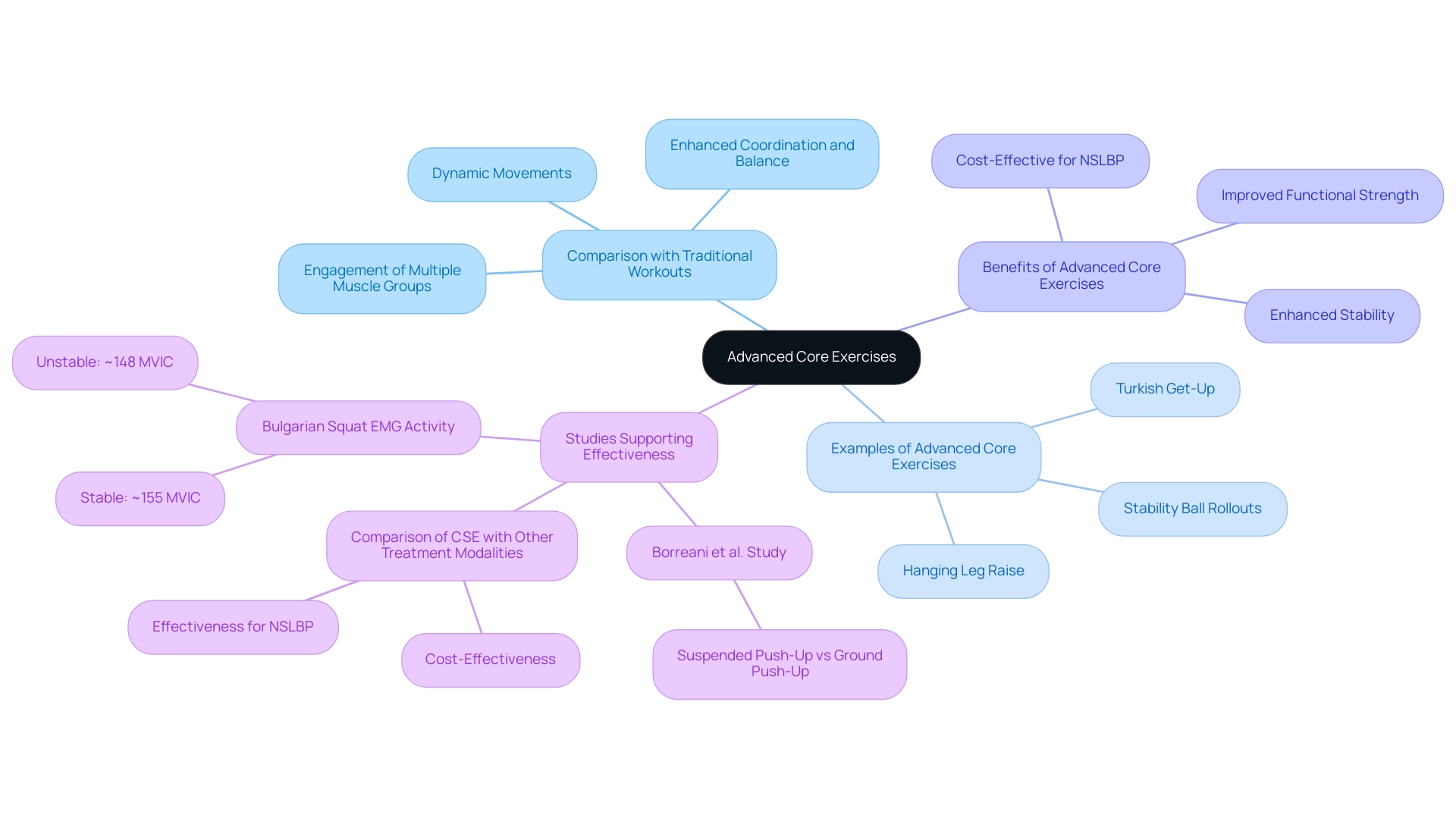
The Importance of Advanced Core Exercises: Benefits for Strength and Stability
Core exercises advanced are crucial not only for building abdominal strength but also for promoting overall body stability. Research indicates that a strong center significantly enhances athletic performance by improving balance and posture, which are essential for effective power transfer during physical activities. In fact, shooting precision in athletes has been demonstrated to enhance from 21.70 ± 3.40 to 25.80 ± 2.70 after implementing focused training of the trunk.
As noted by sports scientist McGill, stiffer abdominal muscles that stabilize the spine tend to be more effective at preventing 'energy leakage', clearly illustrating the connection between abdominal strength and performance efficiency. Furthermore, core exercises advanced are essential in injury prevention; a well-conditioned center supports the spine and mitigates the risk of lower back pain—a common issue for both athletes and individuals in sedentary jobs. Notably, Tian M. and Liu X. (1984) categorized competitive sports, emphasizing that various activities may need customized foundational exercise methods to enhance performance advantages.
The research indicates that fundamental exercise programs should be created to mirror sport-specific actions for optimal outcomes. Furthermore, the assessment of 169 athletes across seven sports revealed that individuals participating in fundamental exercise exhibited notable enhancements compared to those in conventional strength workouts or no exercise at all.
By integrating core exercises advanced into fitness routines, individuals can experience improved functional movement patterns, making daily activities not only simpler but also more efficient. This holistic approach ultimately contributes to a healthier lifestyle, reinforcing the necessity for HR Benefits Managers to promote essential training within their teams.
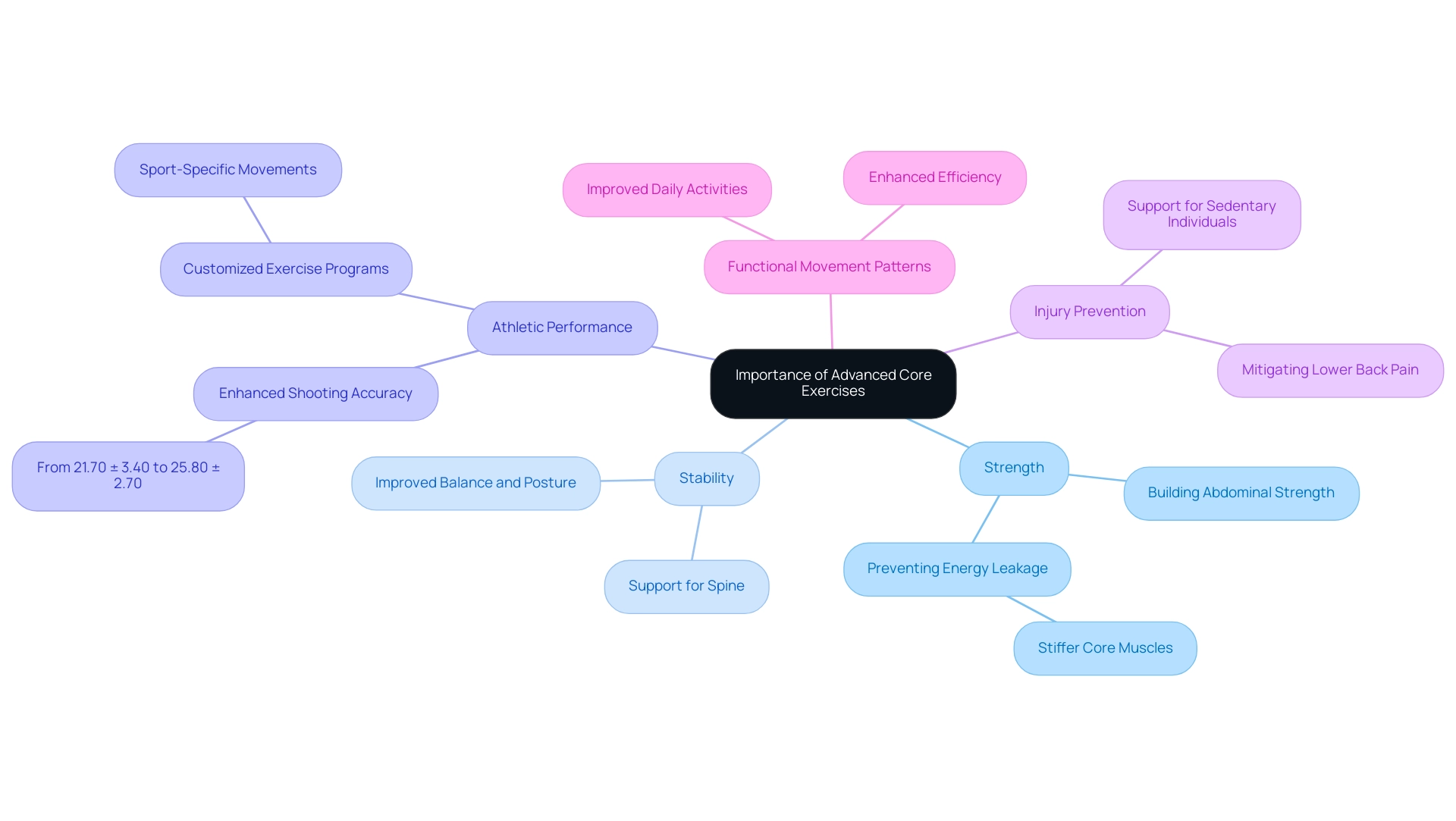
Top Advanced Core Exercises to Enhance Your Workout Routine
For those looking to elevate their fitness routines, here are some top advanced core exercises that can make a significant impact:
- Hanging Leg Raises: This tough movement not only focuses on the lower abdominal muscles but also requires significant upper body power for stabilization, making it a powerful enhancement to any abdominal routine. A study by Weston et al. (2013) with 36 participants (EG = 18, CG = 18) emphasized the effectiveness of such activities in enhancing central strength.
- Stability Ball Rollouts: Engaging the abdomen while rolling a stability ball forward tests balance and coordination, effectively enhancing trunk stability with each movement. According to the systematic review by Martin-Fuentes et al. (2020), activities that emphasize central engagement, like stability ball rollouts, can significantly activate abdominal muscles during workouts.
- Turkish Get-Up: This full-body movement is exceptional for developing trunk strength, stability, and mobility, and is a fantastic example of integrating complex movements into fitness routines. The case study by McGill & Marshall (2012) demonstrated the effectiveness of free-weight activities targeting the rectus abdominis (RA), internal obliques (IO), external obliques (EO), and erector spinae (ES), showcasing the benefits of such integrated movements.
- Plank Variations: By incorporating side planks with leg lifts or plank jacks, you can increase intensity and engage multiple muscle groups, maximizing your workout efficiency.
- Medicine Ball Slams: This dynamic movement not only activates the midsection but also promotes explosive strength and coordination, making it perfect for individuals pursuing functional fitness improvements.
Incorporating advanced core exercises into your training routine can significantly boost fundamental strength and stability, paving the way for enhanced overall performance. Remember, as Rick Richey aptly states, "Just because foundational stabilization activities are the first part of a progressive program, that doesn’t mean they’re easy." They can be very difficult to perform and even more difficult to do well.
Embrace the challenge and watch your fitness soar!
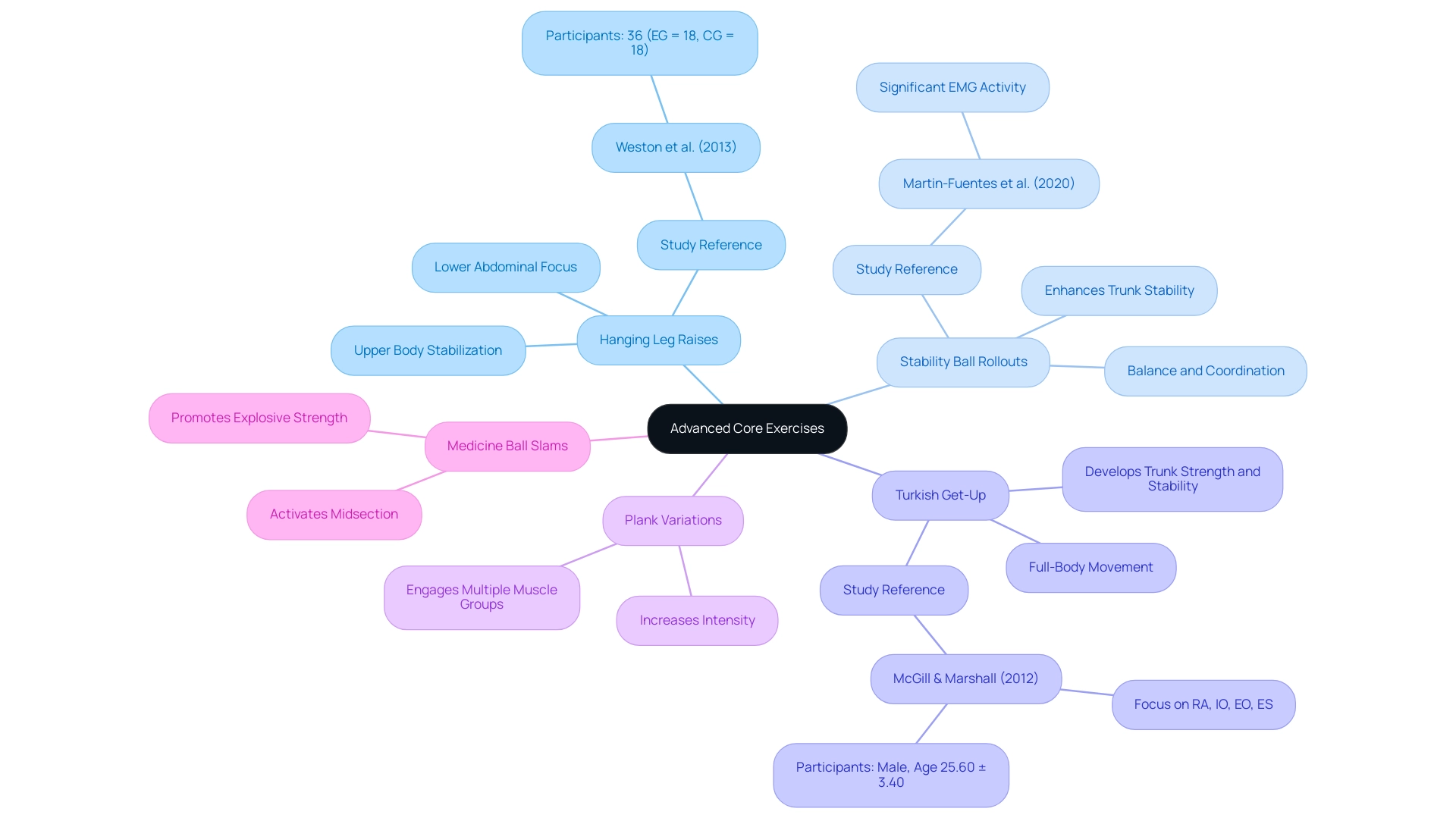
Incorporating Advanced Core Exercises into Your Fitness Regimen
To effectively integrate advanced core exercises into your fitness regimen and elevate your performance, consider the following empowering strategies:
- Assess Your Current Level: Before starting this journey, take the time to evaluate your fundamental strength and overall fitness level. This self-evaluation is essential for choosing activities that match your abilities and ensuring a safe beginning. Recent studies emphasize that further investigation is required on the impacts of foundational training on power and speed during resistance activities, highlighting the significance of grasping your baseline.
- Start Gradually: Introduce one or two advanced exercises per session, allowing your body to adapt and grow stronger. Gradual progression in core exercises advanced not only builds confidence but also reduces the risk of injury while improving your strength. A preliminary effect size calculation suggested that 27 participants were necessary for sufficient sample size in studies, highlighting the significance of appropriate evaluation techniques in essential development.
- Focus on Form: Prioritize proper technique above all else. Mastering the correct form is essential for maximizing the effectiveness of your workouts and preventing injuries. If you're uncertain about your technique, consider collaborating with a knowledgeable trainer for guidance.
- Combine with Other Workouts: Enhance your current workout regimen by effortlessly incorporating advanced abdominal exercises. Combine them with resistance exercises or core exercises advanced, along with cardiovascular workouts, for a well-rounded approach that enhances your overall fitness.
- Set Goals: Establish specific, measurable fitness objectives related to your abdominal power. These objectives will help keep you motivated and provide a clear pathway to track your progress.
As Igor Setuain notes, "Validation and Application of Two New Core Stability Tests in Professional Football" emphasizes the need for effective assessment methods in training. By embracing these strategies, you can successfully elevate your workout routine, foster a culture of fitness, and attain your strength objectives.
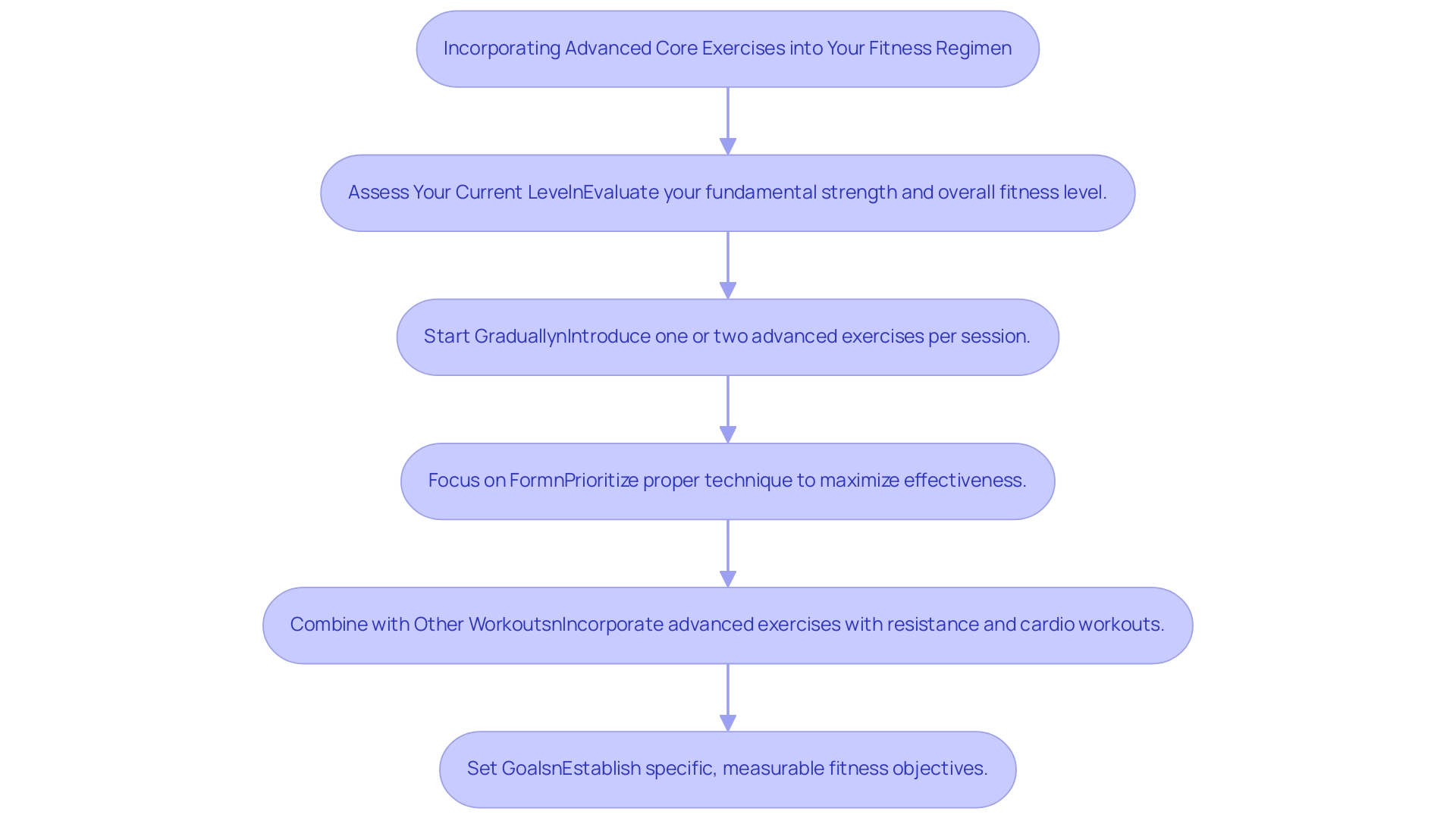
Safety First: Common Misconceptions and Precautions for Advanced Core Training
Participating in advanced fundamental workouts can greatly improve performance, but it’s essential to traverse the terrain with awareness of prevalent misunderstandings and the required safety measures:
-
Misconception: Advanced Activities Are Only for Athletes: Many believe that only athletes can benefit from advanced stability routines; however, these activities can be safely integrated by anyone with proper progression and guidance.
Safety Precaution: Listen to Your Body: Your body is your best ally. Always pay attention to any discomfort or pain, and don’t hesitate to modify or stop activities to prevent injury.
-
Misconception: More is Better: The notion that more repetitions equate to better results is misleading. Instead, prioritize quality over quantity by focusing on fewer repetitions performed with correct form.
Safety Precaution: Warm-Up and Cool Down: A proper warm-up and cool down are essential. These practices prepare your muscles for exertion and facilitate recovery afterward.
-
Misconception: Central Conditioning is Just About Abs: It’s important to recognize that central conditioning encompasses the entire torso, including back muscles, which play a vital role in overall stability.
Recent studies, particularly highlighted in the case study titled 'Emerging Trends in Central Stability Conditioning,' suggest that dynamic, loaded free weight exercises are more effective for developing trunk strength and stability compared to traditional low-load central exercises. This corresponds with the recognition that thorough fundamental conditioning is vital for improving athletic performance.
Moreover, a survey revealed that 35% of participants favored the term 'central' over other expressions, highlighting the significance of suitable terminology in foundational conditioning discussions. The survey group was indicative of people involved in sports and fitness, which enhances the trustworthiness of these misunderstandings and safety measures.
By dispelling these misunderstandings and following these safety measures, you can fully utilize the advantages of core exercises advanced while reducing risks. As Kia wisely states,
Our inner fundamental muscles are important for maintaining inter-abdominal pressure and helping breathe.
This underscores the broader importance of core training in fostering overall well-being and performance.
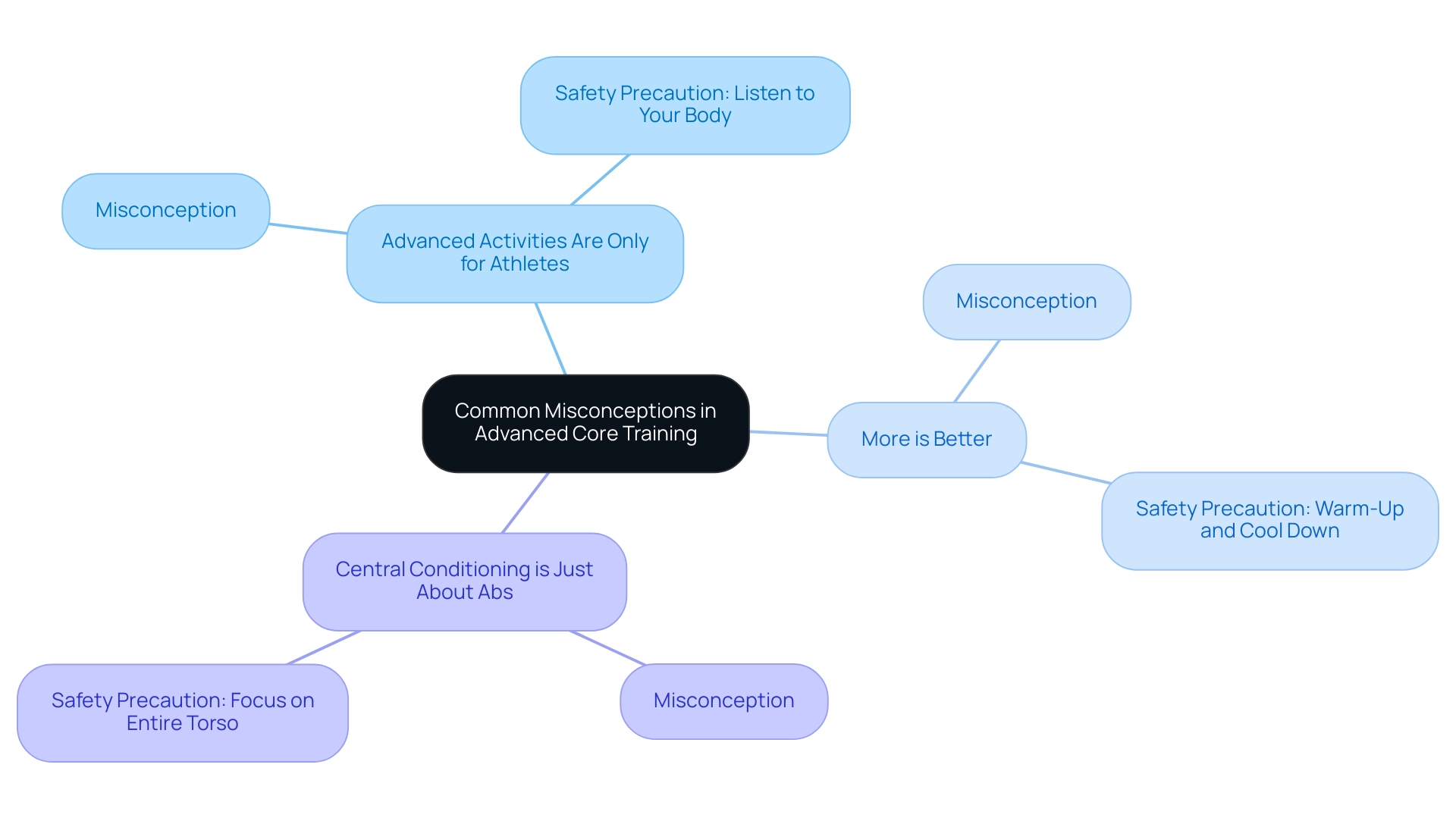
Conclusion
Advanced core exercises are not just a trend; they are a pivotal element in enhancing physical fitness and overall well-being. By moving beyond traditional workouts, these dynamic exercises engage multiple muscle groups, improve coordination, balance, and strength, and significantly boost athletic performance while reducing the risk of injuries. From hanging leg raises to Turkish get-ups, the variety of advanced core exercises available can transform fitness routines and promote a healthier lifestyle.
Incorporating these exercises into daily regimens not only cultivates functional strength but also fosters a culture of wellness within teams. As research consistently highlights their effectiveness, HR Benefits Managers have a unique opportunity to advocate for advanced core training, inspiring their teams to embrace these powerful workouts. Such initiatives can lead to improved performance, enhanced productivity, and a greater sense of community among colleagues.
The journey towards advanced core training is one of empowerment and growth. By understanding the correct techniques, setting realistic goals, and gradually integrating these exercises into fitness routines, individuals can unlock their full potential. The commitment to advanced core workouts is a commitment to holistic health, injury prevention, and a more resilient workforce. Now is the time to take action and prioritize advanced core training for a stronger, healthier future.
Frequently Asked Questions
What are advanced core exercises?
Advanced core exercises extend beyond basic stabilization, challenging core muscles through dynamic movements, instability, and resistance, engaging multiple muscle groups simultaneously.
How do advanced core exercises differ from traditional workouts?
Traditional workouts like crunches and planks focus on simple movements, while advanced core exercises incorporate dynamic movements that require higher levels of coordination, balance, and power.
What are some examples of advanced core exercises?
Examples of advanced core exercises include the hanging leg raise, stability ball rollouts, and the Turkish get-up.
What benefits do advanced core exercises provide?
They enhance functional strength and stability through intricate activation of the midsection, improve athletic performance by enhancing balance and posture, and help in injury prevention by supporting the spine.
What does research say about the effectiveness of advanced core exercises?
Studies have shown that advanced exercises, such as the Bulgarian squat, achieve high levels of muscle activation, and suspended push-ups yield greater activation than ground push-ups, highlighting their effectiveness.
How can advanced core exercises impact athletic performance?
A strong core enhances athletic performance by improving balance and posture, which are crucial for effective power transfer during physical activities. Focused trunk training can lead to significant improvements in shooting precision for athletes.
Why are advanced core exercises important for injury prevention?
A well-conditioned core supports the spine and reduces the risk of lower back pain, which is common among athletes and those with sedentary jobs.
How can HR Benefits Managers promote advanced core exercises?
HR Benefits Managers can motivate their teams to adopt advanced core exercises as foundational workouts, which can ultimately improve overall health and performance.

